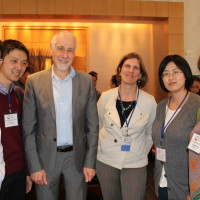Highlights of the President’s FY2017 Budget Request for CISE
 On February 9, 2016, President Obama delivered his Fiscal Year (FY) 2017 Budget Request to Congress. The Request includes approximately $8 billion for NSF and $995 million for the CISE directorate – an increase of approximately $59 million or 6.3 percent above the FY 2015 Estimate for CISE.
On February 9, 2016, President Obama delivered his Fiscal Year (FY) 2017 Budget Request to Congress. The Request includes approximately $8 billion for NSF and $995 million for the CISE directorate – an increase of approximately $59 million or 6.3 percent above the FY 2015 Estimate for CISE.
The CISE request includes $938 million in discretionary funding, plus $56 million in new mandatory funding. This means that for FY 2017, the Administration will be seeking legislation to provide this mandatory funding for NSF on a one-time basis. The purpose of this mandatory funding is to sustain the Administration’s prioritization of research and development (For more information, read the President’s budget message as well as the White House Fact Sheet for the President’s FY 2017 Budget).
The FY 2017 Budget Request for CISE, as in past years, is shaped by investments in core research and infrastructure activities, as well as by investments that support NSF-wide priorities and crosscutting activities. Notably, the Request for CISE is shaped by our increasingly critical role in many national initiatives.
Here are some highlights of the FY2017 Budget Request for CISE:
Strong Commitment to the Core: The FY 2017 Budget Request continues CISE’s strong commitment to our core research programs across investment levels, from single-investigator research to center-scale activities, with increased support across all CISE divisions. These investments will continue to push forward the fundamental knowledge base of our discipline forward and build a solid foundation to support a thriving innovation ecosystem.
Growing Support for Advanced Cyberinfrastructure: The FY 2017 Budget Request for NSF includes significant support for advanced cyberinfrastructure, recognizing its importance in furthering the frontiers of discovery across all areas of science and engineering. Specifically, CISE, through its Division of Advanced Cyberinfrastructure (ACI), will begin transitioning its Cyberinfrastructure Framework for 21st Century Science and Engineering (CIF21) activities (which has long been scheduled to sunset in FY 2017) to two new crosscutting investment areas: the National Strategic Computing Initiative (NSCI) and Data for Scientific Discovery and Action (D4SDA).
NSF’s NSCI activities align with the goals articulated in Executive Order 13702 issued by President Obama in July 2015 and will focus NSF’s efforts on advancing the Nation’s high-performance computing (HPC) ecosystem for scientific discovery and economic competitiveness. NSCI activities are being co-led by NSF, DOE, and the DOD, and involve many other agencies across government; CISE/ACI will represent NSF in this leadership role.
Investments in data – encompassing foundational research; innovative, reusable data and knowledge infrastructure to support data-intensive science; data governance and lifecycle issues; and education of a data-savvy workforce – will remain a strategic focus under D4SDA. This area will be led by CISE and will span research, research infrastructure, and education activities.
Smart & Connected Communities: The FY 2017 Budget Request also includes a new NSF-wide investment for Smart & Connected Communities (S&CC), which aligns with the White House Smart Cities Initiative announced in September 2015. CISE will lead S&CC, which also includes the participation of the Education and Human Resources (EHR); Engineering (ENG); Geosciences (GEO); and Social, Behavioral, and Economic Sciences (SBE) directorates. This area builds on previous CISE investments in US Ignite and Urban Science and aims to improve the quality of life, health, well-being and learning in 21st-century communities. As part of this investment, CISE will support a network of regional research hubs that will advance fundamental research on advanced networking, physical sensors/devices, large-scale data analysis, and control and automation, all with humans in the loop.
Smart & Autonomous Systems: The FY 2017 Budget Request includes a new activity called Smart & Autonomous Systems (S&AS) under the Cyber-Enabled Materials, Manufacturing, and Smart Systems (CEMMSS) investment area. S&AS will focus on fundamental science and engineering that addresses challenges posed by intelligent physical systems that sense, perceive, and operate in environments that are dynamic, uncertain, and unanticipated. This research activity will accelerate the transformation of static systems, processes, and edifices into intelligent, autonomous systems, such as those that can sense, learn, and adapt. S&AS leverages synergistic advances at the interstices of robotics and cyber-physical systems.
Computer Science Education: The FY 2017 Budget Request includes investments in support of the Computer Science (CS) for All initiative that President Obama announced in his weekly address on January 30, 2016. This high-profile attention reflects the central role that computer and information science and engineering has come to play in so many aspects of our daily lives. Our, CS for All efforts, in collaboration with EHR, will support the development of prototypes of instructional materials, assessments, scalable and sustainable professional development models, and teacher resources, along with research to study their effectiveness. The FY 2017 Budget Request also includes investment in undergraduate education through our collaboration with EHR and ENG on REvolutionizing engineering and computer science Departments (RED).
An Emphasis on Early-Career Researchers: The FY 2017 Budget Request includes a special emphasis on early-career researchers. Early-career investigators not only catalyze the next generation of breakthrough discoveries, but also embrace novel approaches for accelerating the research enterprise more broadly – including significant use of computation and data-intensive techniques, along with the pursuit of increasingly interdisciplinary research that falls at the boundaries of traditional academic disciplines.
Continuing Collaborative Efforts: The FY 2017 Budget Request continues CISE’s leadership in a number of crosscutting areas and programs that typically involve multiple NSF directorates and federal agencies. Examples include:
- Secure and Trustworthy Cyberspace(SaTC), which aims to secure our Nation’s cyberspace, is in partnership with the EHR, ENG, Mathematical and Physical Sciences (MPS), and SBE directorates.
- Cyber-Physical Systems (CPS) aims to deeply integrate computation, communication, and control into physical systems. The CPS program is in collaboration with ENG as well as the Department of Homeland Security (DHS), Department of Transportation (DOT), National Aeronautics and Space Administration (NASA), National Institutes of Health (NIH), and U.S. Department of Agriculture (USDA).
- The National Robotics Initiative (NRI) aims to develop the next generation of collaborative robots to enhance personal safety, health, and productivity and is in partnership with ENG, EHR, and SBE, as well as the Department of Defense (DOD), Department of Energy (DOE), NASA, NIH, and USDA.
- Smart and Connected Health (SCH) aims to accelerate the development and use of innovative approaches that would support the transformation of healthcare knowledge, delivery, and quality of life through IT, in partnership with ENG and SBE as well as NIH.
- Cyberlearning and Future Learning Technologies (CFLT) integrates advances in technology with advances in the way people learn. CFLT enables better use of technology to more effectively promote learning, as well as design and evaluate new technologies for integration in learning environments. CFLT is in collaboration with EHR and ENG.
CISE will also continue to participate in other NSF-wide priority areas including Innovations at the Nexus of Food, Energy, and Water Systems (INFEWS), Understanding the Brain (UtB), and NSF Inclusion across the Nation of Communities of Learners of Underrepresented Discoverers in Engineering and Science (NSF INCLUDES). Additionally, CISE is a key participant in the NSF-wide Clean Energy R&D emphasis.
Investments in CISE research, education, and infrastructure have returned exceptional dividends to our Nation. Computer and information science and engineering is ubiquitous, engages and intertwines with many communities, and is a field that is rapidly changing with the potential for profound societal impact. I invite you to continue to work with us to transform the world for decades to come.









